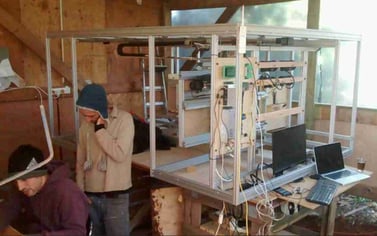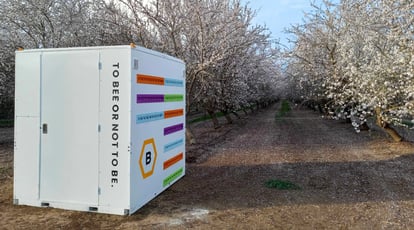As our newest BeeHome model is busy pollinating almonds throughout California's central valley this month, we took a moment to reflect back on how far we have come on our mission to save bees through remote beekeeping. From the earliest prototype, featuring a taped on GoPro, to our newest precision robotics-powered model with a heat chamber for varroa mite treatment, the BeeHome has evolved significantly over the past six years, guided by ongoing market feedback and field data.
The Origins of Remote Beekeeping

Back in 2018, Beewise co-founder, Eliyah Radzyner, had an "aha moment" about the need for remote beekeeping to effectively help commercial beekeepers solve their biggest problem: being able to offer better care to their bees in time to prevent colony collapse. The result was an early prototype with computer vision technology and the ability to extract frames from within a hive for monitoring and treatment. This robotic hive had a mechanism for the extraction of each of the bee-frames, and a camera which automatically took a picture of each frame to be interpreted by our AI, assessing the colony's health and treatment needs.
Designing the First BeeHome
After some initial success with our first remote beekeeping prototype, the Beewise team was eager to begin the process of designing the first BeeHome—a robotic hive that would allow beekeepers to care for their bees remotely. Mock up drawings of this early BeeHome model incorporate a number of key features that are still a part of our design today: the robotic arm that remotely manipulates frames, cameras for remote inspection, adjustable entrances, solar panels to provide a renewable energy source, and the ability to supplementally feed the bees remotely.
The First Generation of BeeHomes
-1.png?width=417&height=313&name=Untitled%20design%20(7)-1.png)
In 2020, we introduced the first BeeHome to the world—a complete redesign of the beehive with advanced technology. This first BeeHome model housed up to 40 hives and allowed beekeepers to remotely treat and care for their bees. We made the decision to use up-cycled, 20-foot long shipping containers as the basic structure for the first BeeHome, allowing us to bring our concept to the field for testing more quickly. These first BeeHomes allowed beekeepers to remotely control climate and receive real-time alerts to any issues within the hive. This first BeeHome in production came at a relatively small scale, with just a few models released. Our team was eager to get the idea to market quickly, gather feedback, and start working on the next BeeHome models incorporating all we learned from this first product release.
The Second Generation of BeeHomes
 Subsequent iterations of the BeeHome aimed to better serve the needs of both commercial beekeepers and the growers who require their pollination services. For the first time, we had hundreds of BeeHomes deployed out in the fields providing pollination to almond orchards throughout California! At seven feet long, these BeeHomes were beginning to get smaller in size, while housing up to 48 distinct colonies in each device. It was still powered by solar panels and featured remotely controllable vents. While the second generation of BeeHomes certainly gained traction in the media and with both growers and beekeepers, we continued to focus on gathering feedback from our users and planning for some significant changes with the next generation of BeeHomes.
Subsequent iterations of the BeeHome aimed to better serve the needs of both commercial beekeepers and the growers who require their pollination services. For the first time, we had hundreds of BeeHomes deployed out in the fields providing pollination to almond orchards throughout California! At seven feet long, these BeeHomes were beginning to get smaller in size, while housing up to 48 distinct colonies in each device. It was still powered by solar panels and featured remotely controllable vents. While the second generation of BeeHomes certainly gained traction in the media and with both growers and beekeepers, we continued to focus on gathering feedback from our users and planning for some significant changes with the next generation of BeeHomes.
Our Latest BeeHome
.png?width=432&height=288&name=Untitled%20design%20(52).png)
In early 2023, we released the BeeHome 4. This model is both smaller and lighter than previous iterations, fitting up to 10 hives in each device. It can be transported on a conventional forklift and fits into existing beekeeping workflows by accommodating standard Langstroth frames. These new features allow for increased hive mobility, enabling beekeepers to effortlessly care for millions of bees and ensuring growers experience sufficient, quality pollination for their crops. The BeeHome 4 also includes a low cost, effective, chemical free heat treatment to fight off Varroa mites that led to the BeeHome being recognized by TIME as a "Best Invention" for the second time.
Looking Ahead
At Beewise, we recognize how critical the input we have received from growers and beekeepers has been to our growth over the years. That is precisely why we have brought to market models of BeeHome that were not yet "perfect". In doing so, we've been able to get the rapid feedback we needed to build the product that our users, growers, beekeepers, and of course the bees, actually need, not what we thought they needed. We remain committed to our culture of innovation and collaboration and will never stop seeking input from our users in order to bring new and improved BeeHome models to the market in our mission to save the bees.
Learn more about using BeeHomes for your next pollination and getting started with Beewise's Beekeeper Network.
.png)
.jpg?width=355&height=199&name=DSC00415%20(1).jpg)


.png?width=355&height=199&name=Copy%20of%20The%20Evolution%20of%20Pollination%20(1).png)
Product Marketing Manager at Beewise
Leave comment